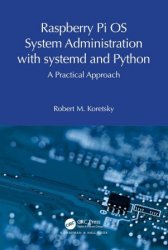 Название: Raspberry Pi OS System Administration with systemd and Python: A Practical Approach
Название: Raspberry Pi OS System Administration with systemd and Python: A Practical ApproachАвтор: Robert M. Koretsky
Издательство: CRC Press
Год: 2024
Страниц: 333
Язык: английский
Формат: pdf (true), epub
Размер: 10.3 MB
The second in a new series exploring the basics of Raspberry Pi Operating System administration, this installment builds on the insights provided in Volume 1 to provide a compendium of easy-to-use and essential Raspberry Pi OS system administration for the novice user, with specific focus on Python and Python3.
The overriding idea behind system administration of a modern, 21st-century Linux system such as the Raspberry Pi OS is the use of systemd to ensure that the Linux kernel works efficiently and effectively to provide these three foundation stones of computer operation and management: computer system concurrency, virtualization, and secure persistence. Exercises are included throughout to reinforce the readers’ learning goals with solutions and example code provided on the accompanying GitHub site.
In the Chapter 2, we give a broad introduction to the Python programming language, using Python version 3. For the beginner Python3 programmer, we illustrate all of its important programming capabilities and syntactic structures, in the context of the three predominant computer programming paradigms: virtualization, concurrency, and persistence. We first give a brief introduction to Thonny, the Python3 Integrated Development Environment (IDE), and then use it throughout the rest of the chapter. We show the details of doing an installation of the latest version of Python3.X on a Raspberry Pi system, instead of utilizing the default installation that comes with the Raspberry Pi OS. We show all of Python3’s critical and basic syntax, including numbers and expressions, variables, statements, getting input from the user, functions, OOP in Python, modules, saving and executing Python scripts, string and sequence operations, and error handling. We also give many basic and practical examples, such as another way of writing shell script files, such as rewriting Bash and tcsh scripts, basic user file maintenance, backing up files, remote copying with the rsync command, and graphics using tkinter. Finally, we show how thread execution is achieved in Python3, and how OOP can be deployed to accomplish it.
This book is aimed at students and practitioners looking to maximize their use of the Raspberry Pi OS. With plenty of practical examples, projects, and exercises, this volume can also be adopted in a more formal learning environment to supplement and extend the basic knowledge of a Linux operating system.
Скачать Raspberry Pi OS System Administration with systemd and Python: A Practical Approach